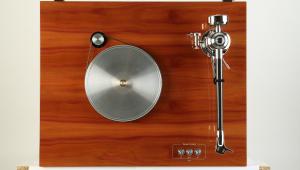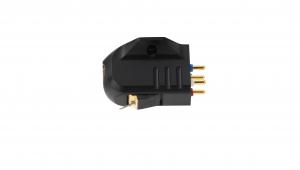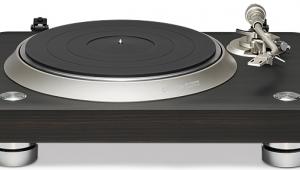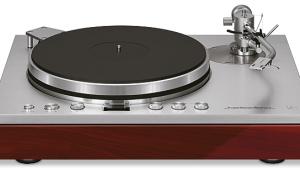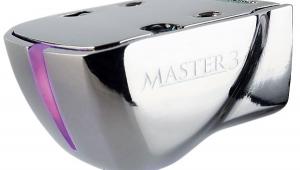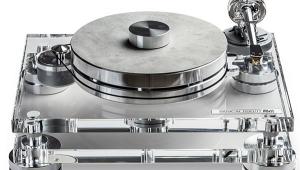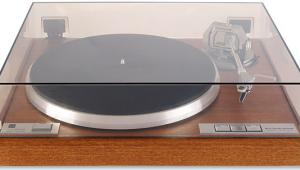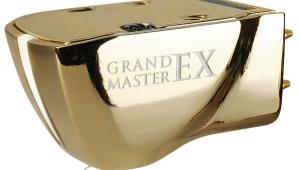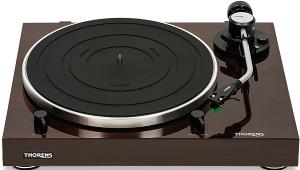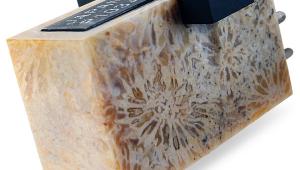Vpi Aries Scout Ii (£1500/£450 Arm)
Last year, an amusing VPI newsletter listed three important events of 1978. Coca-Cola reached China, and the Grateful Dead played at the Pyramids, ‘seeking perfect sound and immortality’. Finally, ‘VPI Industries, Inc, started its first year in business.’ And 30 years on, VPI is still family-owned, building turntables in its small factory in New Jersey. Founder Harry Weisfeld started by making record cleaning machines, then sold his first turntables in 1981. Early models had big wooden cabinets and a heavy-duty sprung subchassis, but this was soon abandoned in favour of suspension feet.
Then, from The New Turntable or TNT, evolved the flagship HR-X, and the rest of the current range. The first JMW Memorial tonearm appeared in 1996, the name a tribute to Harry and Sheila Weisfeld’s older son Jonathan, tragically killed in an accident in 1995.
WELL PRICED
Conceived as an entry level turntable, the Scout was launched in 2002, keeping costs down by avoiding exotic materials or expensive machining processes, and sold complete with JMW 9 arm. Today’s Scout remains pretty much the same, but for minor arm improvements, and still comes at a price that looks attractive even against European competition.
Beneath that satin black finish, the plain-and-simple plinth is made of 1.125in (28mm) thick MDF bonded to a 12 gauge (nearly 3mm thick) steel plate on the underside. The four cone-shaped aluminium feet are attached via rubber-type damping elements and are tipped with stainless steel ball-bearings.
For the inverted main bearing, a half-inch diameter case-hardened steel shaft rises up from the plinth, with a chrome-steel ball set in the top. On this rests the Teflon thrust-plate in the centre of the 35mm-thick acrylic platter, while a brass sleeve provides the journal bearing.
VPI’s brick-like AC motor unit weighs about 2.5kg and is free-standing on its own rubber feet. If you touch it while running, you can feel vibration, but only just, and its motor unit docks neatly in the plinth cut-out without touching, so no disturbances should reach the turntable.
Speed change between 33.3 and 45rpm is by manually moving the belt on the stepped motor pulley. Each section of this pulley is slightly tapered, with a number of grooves for the belt to run in, so moving the belt to lower groove gives a very slight increase in speed.
Over on the other side sits the JMW 9 tonearm. This mounts in a standard Rega-pattern hole, but the pillar has a simple and effective height adjustment, consisting of a knurled screw ring which is turned to lift the arm up or let it down, before finally locking it with a hex bolt. You can adjust so-called VTA ‘on the fly’, if you are careful.
Like the product itself, the instructions are down-to-earth and direct, as for example ‘You will get used to the loose feeling of the unipivot; it is not loose and is actually one of the most stable tonearm designs.’ Installing a cartridge is made easy because the arm wand simply lifts off as a complete unit. VPI provides an alignment gauge to position the cartridge, but then says disarmingly ‘Do not go crazy over this adjustment, it is only mildly critical.’ You imagine that VPI must have encountered a good few alignment-obsessives over the last 30 years. But despite the clarity of the instructions, setting the tracking force and azimuth takes some patience and if you are inexperienced, it’s best left to the dealer the first time.
VPI’s record clamp is fairly easy to use as it locates reliably and spins down the quick thread on the spindle in about four turns. With a rubber washer under the record raising the centre slightly, the clamp expels the air under the disc and flattens it against the platter, but without the severe and sometimes record-cracking dishing action of the original Oracle clamp, for example.
I would have liked to do without the clamp, but found it a definite improvement. It makes the bass firmer and more rhythmic, while the harmonic structure is better revealed. Image depth was improved, with voices or instruments now located more tangibly. So, clamp at the ready, I began listening seriously, using first an Ortofon Kontrapunkt A and alternatively a Koetsu Black.
SOLID BASS
Taking ‘Cocaine’ with Eric Clapton on Slowhand [RSO 2479 201], I found immediately that the bass line was solid and unequivocal, the notes even in weight through the scale and free of any tendency to boom out on certain pitches. Also, you could really hear the bass notes start and stop, keying in the rhythm of the whole track. On a number like ‘Next Time You See Her’, which depends on a repeated rhythmic figure, the rather messy multitude of instruments pulled together.
From the very start of ‘The Changeling’, the Doors’ LA Woman [Elektra K42090] was intense and gutsy, keyboards and guitar cutting through savagely. You could perhaps criticise a tendency to brashness in the treble, a sense that there could be a bit more depth and resonance to the sound of Morrison’s voice. But as with almost every track I played, the VPI managed to make the listener feel that the music was a coherent entity, a creation that made sense, and in this case a creation of rather frightening passion.
With Bob Marley And The Wailers Live [Island ILPS 9376] from 1975, the VPI seemed to give a characteristically well-founded no-nonsense presentation. With a fine and stable sounding bottom end as the foundation, it gave a solid and persuasive account of the event, the brasher instrumental sounds seemingly tamed and moulded into a coherent picture. With ‘I Shot The Sheriff’ and ‘Get Up, Stand Up’, you were left in no doubt that you were listening to an era-defining live performance.
On that direct-cut perennial The King James Version [Sheffield Lab LAB 3], I was impressed by the depth layering in the sax and brass sections, a feeling that there was something solid there, and the saxes sounded as warm and dark as toffee. As always, what matters is the overall effect, the music as a whole, though contrarily, it’s sometimes the tiniest details that tell you something is more or less right.
In this case, even after being impressed by Les DeMerle throwing everything at the kit in the last chorus of ‘Corner Pocket’, it was the realism of a couple of little throwaway cymbal strokes in the coda that had me convinced.
MAKING SENSE
Next I put on Muddy Waters: Folk Singer, where Muddy was unplugged, to justify the title, but with cavernous studio echo to compensate. On the celebrated if interventionist audiophile reissue by Discovery [HDR 1001], the VPI did a fine job in presenting Muddy’s deepest vocal tones, keeping both his voice and the low notes on his guitar intelligibly separated from a sometimes blurrily-echoing bass and drums. In other words, the VPI did make sense of this famous but flawed recording.
Getting on to a bit of a Decca SXL jag, one of the classical records I put on was the Brahms Symphony 2 with the Vienna Philharmonic and Istvan Kertesz from 1965 [Decca SXL 6172]. There was a good depth and distance in the orchestra, and the pulse of the music was always firm. By contrast, I also enjoyed the warmth, strength and clarity of the Janacek Quartet playing Haydn’s ‘Joke’, ‘Serenade’ and ‘Fifths’ quartets [Decca SXL 6093].
Listening to the Scout, I soon found myself sitting back through whole sides rather than rushing to the next album and the next test track. I found the bass quality outstanding, both when the player was placed on a solid brick and tiled hearth and when it had to contend with a slightly dodgy suspended floor. It managed to produce convincing imagery, which above all had a quality of solidity and unity.
It was excellent on mono LPs too, presenting a good feeling of depth where it existed in the recording, with a seemingly appropriate-sized ‘image’ between the speakers.
PLUG 'N' PLAY
On the minus side, I felt that the Scout’s treble never actually sparkled, and the sound overall had what I can only describe as a very slightly grey quality, sounding slightly damped.
Yet I feel that VPI’s trade-offs are sensible and make this a more appealing product than those which tend towards a colourful over-brightness or lack of bass control.
In the end, the Scout is an honest no-frills design that still takes care of the essentials. As the new UK distributor says, this is not a tweaker’s turntable, more like a plug-and-play solution that continues to work well once set up.
On the other hand, it is upgradeable. You can always add more elaborate feet or a dedicated synthesiser power supply, for example, or a heavier platter weight. Or you could get embroiled in a search for the best interconnect – VPI supplies its own, but the distributor recommends Nordost’s Red Dawn.
By doing all this you could, I guess, make worthwhile improvements to the overall sound, but in doing so double the price of the turntable. But that doesn’t detract from the merit of the Scout package as it stands. It is, quite simply, good value.
VERDICT
It might lack the machined-for-the-love-of-it appeal of the Michell Gyro, or the acrylically-clean looks of a Clearaudio or the Roksan Radius, and sonically, it doesn’t manage the rhythmic pace or dynamics of a Rega, for example. But the VPI Scout does offer a reliably good and solid bass performance, convincing stereo imaging, and a sound that is satisfyingly ‘all of a piece’. It’s genuinely well worth the money.
This review was originally published in the November 2009 issue.






